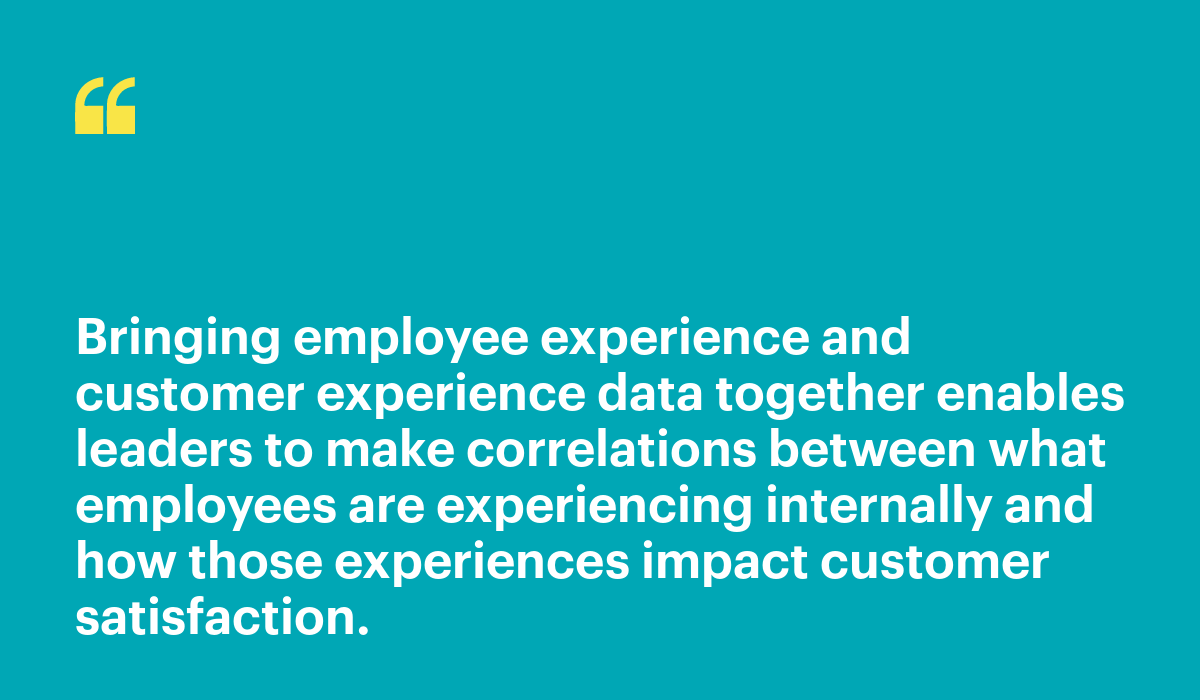Unlock Your Employee Experience’s Full Potential With Customer Experience Data
Learn how leveraging customer experience data can improve your employee experience, which results in higher productivity and more revenue

Customer experience plays a pivotal role in establishing a sustainable, profitable business. When you take good care of your customers, they help you grow, which is why most companies have dedicated teams, processes, and technology focused on understanding customer needs and creating positive experiences for them. Unfortunately, many organizations miss the fact that their employees—the same people responsible for delivering on those experiences —require this same attention and care.
Customer experience and employee experience go hand in hand. In fact, a study by Forbes Insights in association with Salesforce points out that companies with high employee experience and customer experience scores grow almost twice as fast as their counterparts. Even though work culture has a direct impact on productivity and the bottom line, it can be difficult to figure out how to improve the employee experience.

What is employee experience and how does it influence the customer experience?
Employee experience is the employee’s perception of the entire journey they have at an organization. From “interview-to-exit,” every moment, every interaction and every touch point and transaction in the employee lifecycle constitutes their entire experience.
Employee experience directly shapes the interactions your customers have with your organization. That’s because happier employees are more engaged. When you take steps to develop a more positive company culture, where your people’s wants and needs become a priority, you unlock new opportunities for your organization. Your employees become better equipped to serve your customers and have an even greater impact on the business.
To make this a reality, you need to focus on gathering data about both employee and customer experiences. That way, you can start to see how these areas relate to each other—and how pulling different employee experiences levers results in better returns on revenue and customer satisfaction.
Four reasons to combine your employee experience and customer experience data
While this level of focus on employee experience may be relatively new to many organizations, most know how important it is to collect and share customer experience data. To make better business decisions, combine your employee and customer experience data and use these connected insights to:
Give leaders a 360-degree view
Uncover internal root causes of external issues
Drive quick and effective action
Facilitate alignment across teams
1. Give leaders a 360-degree view
Getting customers’ point of view is just half the picture. Your employees have a unique view of your processes, procedures, and systems that your customers don’t. They can tell you what is serving your customers well and what’s not. When management teams have this full visibility, they can improve both customer and employee experience.

2. Uncover internal root causes of external issues
Bringing employee experience and customer experience data together enables leaders to make correlations between what employees are experiencing internally and how those experiences impact customer satisfaction.
For example, one business saw the power of connecting this data when they found that staffing shortages at their contact center were resulting in long hold times. The staffing shortage put extra pressure on employees, and also had a significant impact on the customer experience.
3. Drive quick and effective action
Give every leader on your team, from the executive level to people managers, the ability to determine what will make the biggest impact on their employee and customer satisfaction right away. The right experience management and people analytics technology not only captures and analyzes the data, but also makes it actionable by automatically routing tailored insights and suggested actions to the right stakeholders across the organization who are best equipped to respond.
4. Facilitate alignment across teams
You cannot see the complete picture of your organization without the voice of your customer and employee. They are both equally important, and you can make sure that both are heard by combining employee and customer initiatives. Merging the two programs into one platform accelerates learning and innovation and helps facilitate alignment between HR and operational teams.
Make better decisions, together
Looking at employee experience and customer experience data together allows you to stop guessing, and make investments in the people, tools, and resources that will have the greatest impact on your employees and customers. By leveraging modern technologies that work seamlessly together to analyze your customer and employee experience data, you remove any obstacles that stand in the way of positive change.
Visier and Medallia collaborate to bring people and employee data together, giving HR and people leaders comprehensive insights. To learn more about getting a complete view of employee experience and customer experience, read our full white paper: Designing Great Employee Experiences: The Power of Combining Employee and Customer Experience Data.


